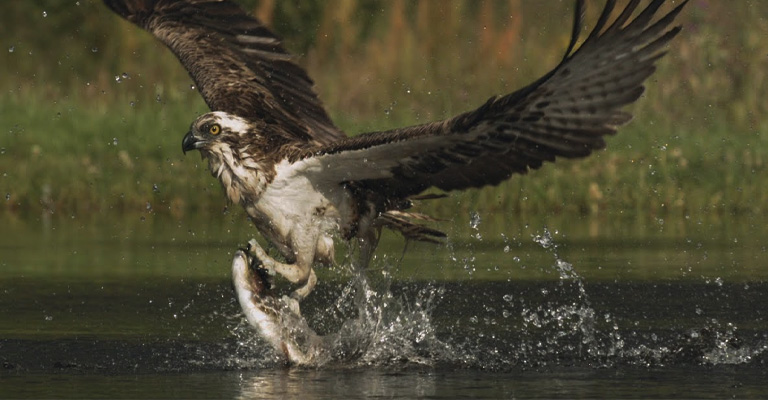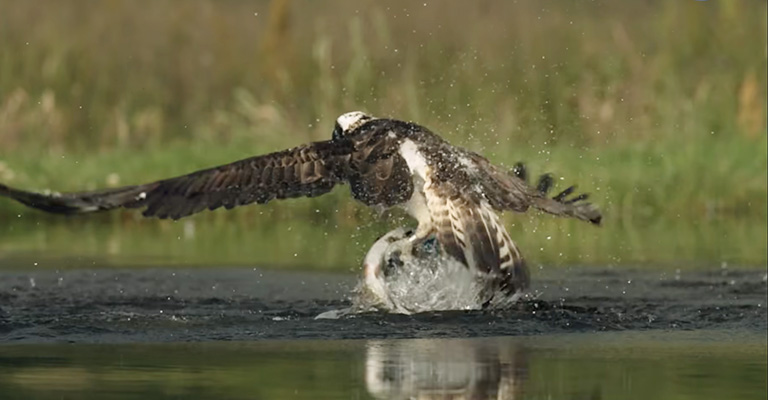The bald eagle, America’s iconic national bird, is renowned for its majestic presence and impressive hunting skills. But have you ever wondered if these regal birds of prey take to the night sky in search of their prey?
Do bald eagles hunt at night? In this exploration, we delve into the intriguing question of whether bald eagles hunt at night. Known for their remarkable vision and hunting abilities during the day, bald eagles are often associated with diurnal activities.
While these magnificent raptors are predominantly diurnal hunters, it’s not uncommon for them to extend their forays into the night, particularly under specific circumstances.
However, as creatures of adaptation, they exhibit fascinating behaviors that extend beyond daylight hours.
Join us on this journey to uncover the secrets of the bald eagle’s nocturnal activities and discover whether these iconic birds ever spread their wings under the cloak of darkness in pursuit of their next meal.

Do Bald Eagles Hunt at Night?
To answer the question of whether bald eagles hunt at night, we must delve into their biology, behavior, and the unique adaptations that allow them to excel as apex predators.
While these birds are primarily associated with daylight hunting, there are intriguing aspects of their behavior that hint at potential nocturnal activities.
Let’s explore the world of the bald eagle and uncover the secrets of its hunting habits, both day and night.
The Diurnal Nature of Bald Eagles
Bald eagles are widely recognized for their diurnal, or daytime, hunting behavior. Their large size, powerful wings, and incredible eyesight make them formidable hunters during daylight hours.
Diurnal raptors, such as eagles and hawks, rely on their sharp vision to spot prey from great heights and then pursue it with precision. A bald eagle’s eyesight is truly remarkable.
Their eyes are specially adapted for detecting movement from afar. With vision up to four times sharper than that of a human, they can spot fish swimming near the surface of water or other prey on the ground or in the water, even from several hundred feet in the air.
This exceptional visual acuity, combined with their hunting skills, allows bald eagles to capture a variety of prey, with their primary food source being fish.
They often perch in trees or soar above the water, waiting for an opportunity to strike and grasp their prey with powerful talons.
The Potential for Nocturnal Activities
While bald eagles are primarily associated with diurnal hunting, there are instances where they may exhibit nocturnal behaviors. These behaviors are not necessarily hunting-related but are worth exploring:
Hunting Near Dusk and Dawn
Some bald eagles may extend their hunting activities into the crepuscular hours—dawn and dusk. During these transitional periods between day and night, they can benefit from both dim natural light and their excellent vision, making it easier to spot prey.
Moonlit Fishing
Moonlight can provide sufficient illumination for bald eagles to engage in fishing during the night. Moonlit waters might offer opportunities to hunt for fish near the surface, similar to their daytime foraging.
Scavenging at Night
While not actively hunting, bald eagles may scavenge for food at night. They are opportunistic feeders and may investigate carrion or unattended prey after dark.
Adaptations for Nighttime Vision
Bald eagles have adaptations that allow them to see well in low light conditions, which could be advantageous during dawn, dusk, or moonlit nights:
Large Pupils
Their eyes have larger pupils that can dilate or contract to control the amount of light entering. This adaptation enables them to adjust to different light levels.
Reflective Tissue
Bald eagles, like other birds of prey, have a specialized reflective layer of tissue behind the retina called the tapetum lucidum. This layer enhances their vision by reflecting and amplifying light, improving their ability to see in dim light.
The Importance of Diurnal Behavior
It’s crucial to understand that while bald eagles may display some nocturnal behaviors or extend their hunting activities during twilight hours, their diurnal nature remains fundamental.
Their physical adaptations, including their sharp vision and strong beaks and talons, are primarily designed for daylight hunting. Furthermore, there is limited evidence to suggest that bald eagles actively hunt during the darkest parts of the night.
Most records of their nighttime activities involve nesting behavior, vocalizations, or opportunistic feeding rather than active hunting.
How Do Bald Eagles Hunt?

Bald eagles, with their regal appearance and powerful presence, are renowned for their prowess as hunters. These apex predators are emblematic of North America and are celebrated as national symbols.
But what makes bald eagles such effective hunters? To answer that question, we must delve into their remarkable hunting strategies, physical adaptations, and the secrets behind their successful hunts.
Exceptional Vision
One of the most remarkable features of bald eagles is their extraordinary vision. Their eyes are perfectly adapted for spotting prey from great distances, even while soaring high in the sky.
Their visual acuity is up to four times sharper than that of a human, allowing them to detect movement and identify potential prey with astonishing precision.
Bald eagles rely on both binocular and monocular vision. Binocular vision helps them judge distances accurately, while monocular vision enables them to see a wide field of view. This dual vision capability is especially advantageous when scanning for prey from high altitudes.
The Hunt from Above
Bald eagles are renowned for their distinctive hunting technique—hunting from above. They soar at great heights, riding thermals and taking advantage of updrafts.
This aerial vantage point allows them to survey a vast area for potential prey. When a suitable target is spotted, they can rapidly descend to execute a precise strike.
Opportunistic Feeders
Bald eagles are opportunistic feeders, meaning they adapt their diet to the available food sources. Their primary food source is fish, and they are exceptionally skilled at catching fish near the water’s surface.
They can spot fish swimming just below the surface and execute dramatic aerial dives to capture them with their sharp talons.
However, they are not limited to fish alone. Bald eagles will also prey on a wide variety of other animals, including waterfowl, small mammals, and carrion. They may scavenge from the remains of other animals or compete with other scavengers for a share of the spoils.
The Mighty Talons
Bald eagles are armed with formidable weapons for hunting sharp talons. These talons are incredibly strong and are adapted to clutch and secure prey.
When the moment comes for an attack, bald eagles use their talons to snatch their quarry from the water or land with remarkable precision.
Their grip is so strong that they can carry prey that may be heavier than themselves, making them efficient hunters of various sizes of animals.
Coordinated Hunting
Bald eagles are known to engage in coordinated hunting strategies, particularly when hunting fish. They may work in pairs, with one eagle startling or herding the fish while the other swoops in to seize the prey.
This collaboration enhances their chances of success when targeting schools of fish.
Territorial Behavior
Bald eagles are highly territorial birds, and they often have established hunting territories. These territories encompass prime hunting grounds, which they defend vigorously from other eagles and potential intruders.
Maintaining a reliable food source is essential for their survival, and their territorial nature helps secure their access to prey.
Adaptation to Varied Habitats
Bald eagles are adaptable when it comes to their hunting grounds. While they are most closely associated with coastal regions and large bodies of water, they can be found in various habitats, including lakes, rivers, wetlands, and even some urban areas.
They are opportunistic and will adjust their hunting techniques to suit the environment and the availability of prey.
Success and Efficiency
Bald eagles are highly successful hunters due to their exceptional eyesight, aerial hunting techniques, and sharp talons. Their success rate in capturing prey is quite high, particularly when hunting in their preferred habitat near water.
However, they also face challenges, such as competition for prey, the need to defend their territory, and the risk of injury during hunts.
FAQs
Do bald eagles hunt cooperatively?
Yes, bald eagles are known to engage in cooperative hunting, particularly when targeting fish. They may work in pairs, with one eagle herding or startling fish while the other swoops in to capture the prey.
What types of prey do bald eagles hunt, aside from fish?
While fish are their primary food source, bald eagles are opportunistic hunters and will feed on a variety of animals. Their diet may include waterfowl, small mammals, carrion (scavenged animals), and occasionally larger prey like other birds or small mammals.
How fast can a bald eagle dive to catch prey?
Bald eagles are impressive divers, and they can reach speeds of up to 100 miles per hour (160 kilometers per hour) when executing a high-speed dive to capture prey, particularly when hunting fish.
Do bald eagles ever steal food from other birds or predators?
Yes, bald eagles are known to engage in kleptoparasitism, where they steal food from other birds or predators. They may harass other birds, such as ospreys until they drop their catch, which the bald eagle then claims for itself.
How far do bald eagles travel to hunt for food?
The hunting territory of a bald eagle can vary depending on factors like food availability and nesting location. Some eagles may have relatively small territories, while others may cover a larger area. Eagles have been known to travel significant distances to find food.
Conclusion
In the realm of the bald eagle’s hunting habits, we’ve unraveled the mystery surrounding their nocturnal activities. As we’ve uncovered, their remarkable vision, honed for daylight hunting, can serve them well in moonlit conditions.
Bald eagles might seize opportunities presented by moonlight, such as hunting fish near the surface of water or taking advantage of the activities of other nocturnal animals.
However, it’s important to emphasize that bald eagles primarily rely on daylight for their hunting expeditions. While they possess adaptability, their diurnal nature remains their core hunting strategy.
The bald eagle’s ability to navigate both the day and night skies speaks to their exceptional adaptability and resourcefulness as apex predators.
Whether soaring under the brilliance of the sun or the soft glow of moonlight, these birds continue to captivate our imagination and inspire awe, solidifying their status as a symbol of strength and freedom in the United States.